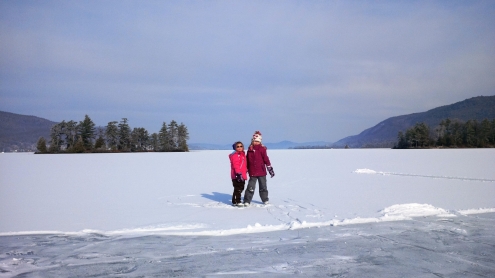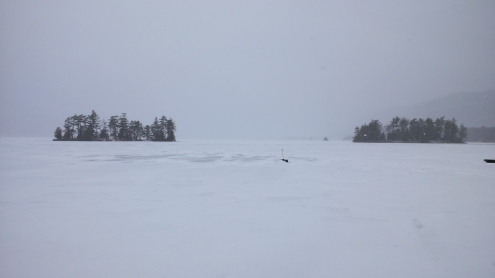Click image to read newsletter.
Name-The-View Fundraiser for Berry Pond

You could win the right to “name-the-view” in the Lake George Land Conservancy’s (LGLC) fundraiser. (Click image to see full-scale.)
The public is invited to participate in the Lake George Land Conservancy’s (LGLC) Name-The-View drawing, a fundraiser for the Berry Pond Preserve in Lake George.
One drawing winner will be given the right to name the view from Berry Pond’s northern overlook, and will also receive a catered picnic for eight on Dome Island, complete with transportation and tour of the island. The drawing will take place this summer at LGLC’s Annual Meeting on July 17th.
In 2008 the Lake George Land Conservancy took on $2.654 million of debt to purchase the 1,435-acre Berry Pond tract and protect it from further development. This purchase represents LGLC’s commitment to the West Brook Conservation Initiative, an agreement between three Lake George environmental agencies, the Village of Lake George and Warren County, working together to protect the lake from polluted West Brook inflow in Lake George Village.
LGLC’s Executive Director Nancy Williams, explains, “Berry Pond has become a beloved recreational asset for hiking and winter use to residents and visitors to Lake George. It is a vital link for snowmobilers between Warren and Washington County. The LGLC purchased the land in order to provide for these recreational uses and to stop development on the mountain, an event that would have delivered more nutrients and sediments into Lake George.”
Berry Pond includes high peaks overlooking Lake George and provides spectacular views of the Narrows and Rattlesnake Cobble. The tract is home to the headwaters of West Brook, and three tributaries cross the Berry Pond tract to flow into West Brook as it passes through Gaslight Village and into Lake George.
To enter the drawing and for more information visit: www.GoFundMe.com/Berry-Pond-Lake-George. A donation is not required to enter the drawing, but is encouraged.
Land Conservancy Honors Apperson with Annual Walk on Water

Participants walk to Dome Island during the “Walk on Water,” sponsored by the Lake George Land Conservancy and the Dome Island Committee.
Thanks to an old-fashioned winter with plenty of snow and ice, the Lake George Land Conservancy (LGLC) was able to hold its annual Walk on Water on February 15, 2014. Donning snowshoes and skis, eighty-eight people participated in the coveted trek out to Dome Island.
Scheduled each February as a collaborative effort between the Lake George Land Conservancy and the Dome Island Committee, the Walk on Water is a unique opportunity for the public to visit Dome Island.
The island, which is preserved and off-limits to the public, was donated by John S. Apperson Jr. (1878-1963) in 1956 to The Nature Conservancy with a $20,000 endowment for its continued preservation. Today Dome Island remains one of the few islands on which no structures have been erected, and because of its unique “un-touched” quality is used for research.
Apperson was an avid sportsman and a life-long and tireless conservation activist whose efforts throughout the Adirondacks, especially on Lake George, successfully preserved much of what we love today about the region.

Participants standing offshore near Dome Island.
Walk on Water participants were able to climb onto Dome Island to see a plaque dedicated to Apperson in recognition of his donation and work to preserve Lake George.
Three separate groups were taken out to the island, each led by a member of the Dome Island Committee, a group of local residents who oversee the Apperson endowment. The leaders provided an historical background and experienced guidance over the mile-long trek.
Afterward, Katie Bruening, a participant in the noon excursion, said, “Thank you for a wonderful experience! On Saturday my sister, her 15 year old son, my 11 year old son Carson and I enjoyed snowshoeing out to Dome Is and exploring the Is. Our leaders for the 12:00 excursion were knowledgeable and helpful. When we were on our way home Carson said, “Mom, that was a great day”. Having opportunities like this and the Hike-a-thon (which we did in July) help us all appreciate Lake George on a deeper level. Your hard work for these events and all that you do to help protect the Lake George region is greatly appreciated.”
Dependent on the lake’s ice conditions, the Walk on Water is not guaranteed; because of past warmer than usual winters, this was the first Walk on Water since 2011. Despite its uncertainty, however, each year the event attracts dozens of people hoping to take part.
To see more pictures from the day, go to the Picasa Photo Album
(Click images to see full-scale.)
Mutual Aid Ice Rescue Drill a Success
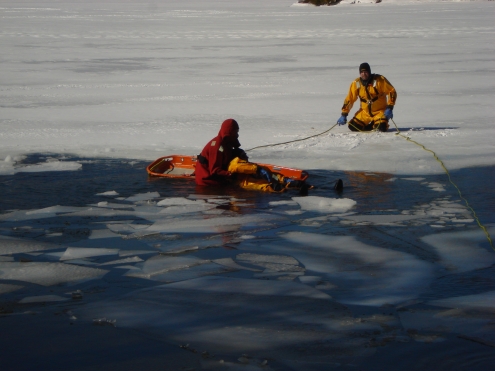
A simulated ice rescue drill was done today by the the Huletts Landing Volunteer Fire Department in cooperation with both the Dresden and Whitehall Volunteer Fire Departments. (Click image to see full-scale.)
Today, Sunday February 16th, with temperatures around 10 degrees, the Huletts Landing Volunteer Fire Department in cooperation with both the Dresden and Whitehall Volunteer Fire Departments, held a mutual aid ice rescue drill at the Huletts Island View Marina on Lake George.
The drill was coordinated by Jay VanderPlaat, Huletts Landing Fire Chief, and the training was done by Brian Brooks, Whitehall Fire Chief. There were 28 men present with 10 coming from Huletts.
The wind was fierce and the air was bitter cold but, but all the volunteers gave it their all and the training was a huge success. They were flanked by a good many spectators who braved the cold to watch the event.
The Women’s Auxiliary provided the firefighters with a hot lasagna meal back at the Huletts firehouse at the conclusion.
Below are pictures from today’s training. (Click all images to see full-scale.)

Whitehall’s ice rescue boat was used on Lake George.
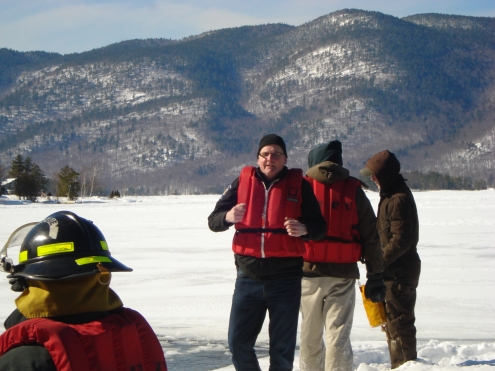
Brian Brooks, Whitehall Fire Chief, (in black hat) conducted the training.
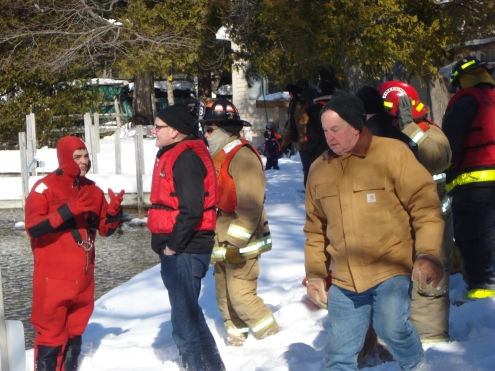
Huletts, Dresden and Whitehall Volunteers in front of the Huletts Island View Marina.
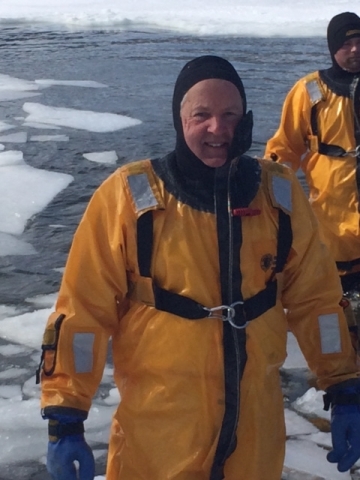
Huletts Volunteer Fireman, Terry Storms, was the simulated “man in the water.”
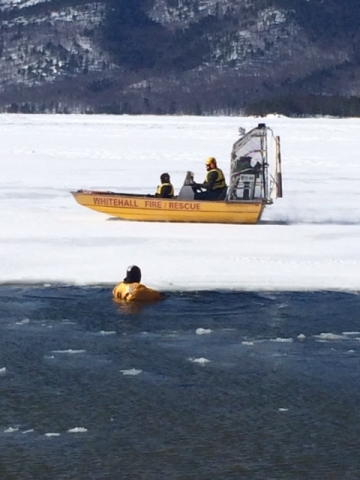
Great caution was taken to make the drill realistic but also safe for the volunteers involved.
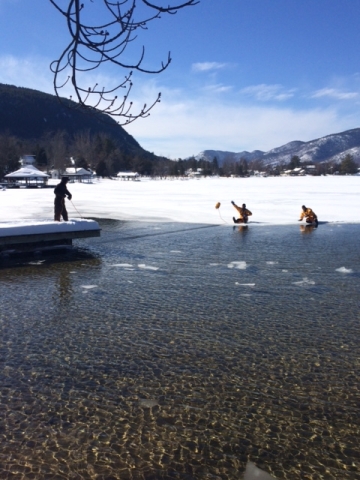
The weather was brutally cold.
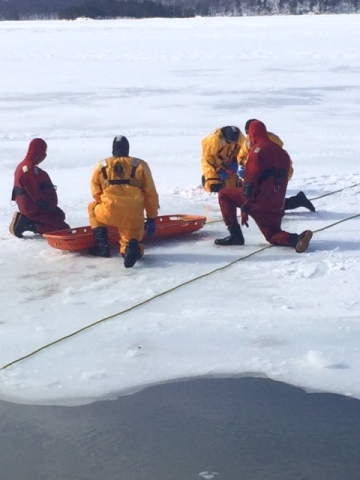
Coordination was done by the volunteers on the ice and on the land.
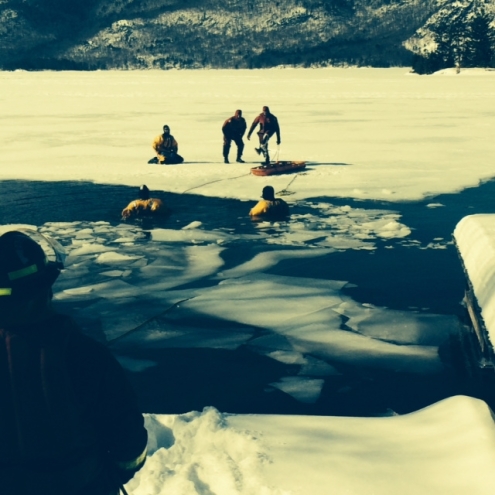
All-in-all, it was a day in the history of Huletts Landing.
Many thanks go out to Fire Chiefs, VanderPlaat and Brooks, for coordinating this training as well as all the volunteers who made the day a success.
Lake George Winter Carnival Begins
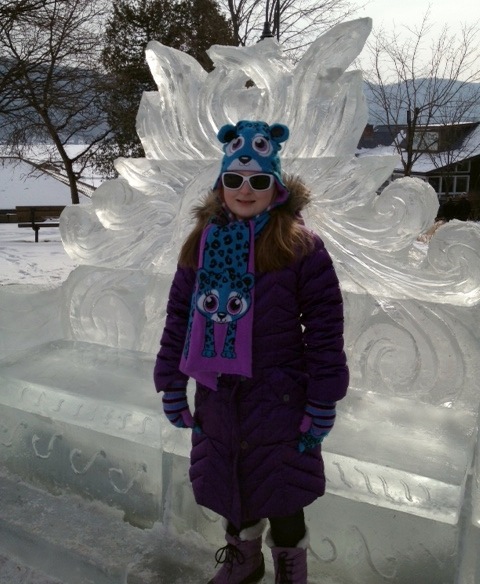
Margot Kapusinski stands in front of an ice sculpture at the 53rd annual Lake George Winter Carnival. The Carnival opened this past weekend and runs every Saturday & Sunday in February.
Denton Publications reviews it here.
The official website is: http://www.lakegeorgewintercarnival.com/
LGA Awarded Grant for Stormwater Mitigation Project at Mossy Point Boat Launch
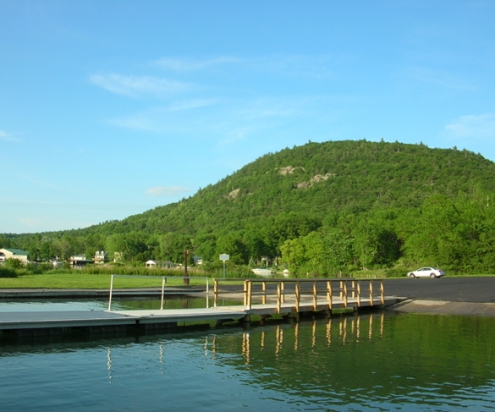
The Mossy Point Boat Launch in Ticonderoga (DEC Photo).
The Lake George Association is pleased to announce that it has been awarded a $15,000 Pollution Prevention grant from the Lake Champlain Basin Program for Stormwater Mitigation at Mossy Point Boat Launch on the northern end of Lake George in Ticonderoga. The project will retrofit the 3.5 acre boat launch area/ parking lot and try to capture and treat stormwater runoff that is currently entering the lake untreated using several different filtering methods including; a vegetated swale, rain gardens, infiltration beds and porous pavers. Matching funds for the project will be provided for by the LGA through the Helen V. Froehlich Foundation and by the NYSDEC.
In the summer of 2012, the Warren County Soil and Water Conservation District (WCSWCD) was asked by the Town of Ticonderoga to complete a town wide stormwater outfall assessment. Included in the assessment was the 3.5-acre Mossy Point boat launch site that is comprised of approximately 30% pavement and 70% compacted cinder stone dust. The final report identified the Mossy Point boat launch area as a priority project listing the numerous solutions to capture the flow from the site that is carrying sediments, road salt and other pollutants.
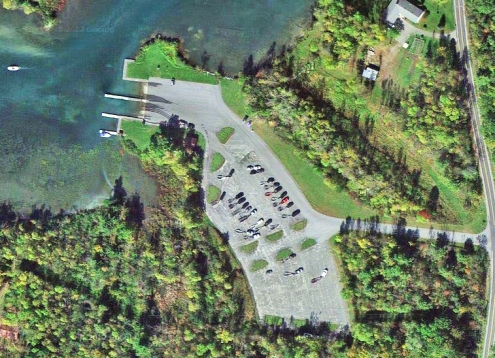
The Mossy Point Boat Launch as seen from above in Google Earth.
“We are pleased to have received funding to implement this project which includes the solutions outlined in the report as well as final design work, project oversight and the use of porous pavers,” said Randy Rath, LGA’s Project Manager. “We will work this spring and summer to survey the site, take elevations, and create the final design. Construction is tentatively scheduled for late summer/early fall. We will be working with Warren County Soil and Water and the DEC on this project moving forward, but if it wasn’t for the Town of Ticonderoga having the stormwater assessment done, we wouldn’t have been able to get this all pulled together so quickly. It is just another example that goes to show how important our partnerships really are for protecting the Lake.”
The initial concept calls for a long vegetated swale along the side of the roadway entrance to the launch that would direct runoff into a rain garden or bio-retention area. Additional rain gardens and a berm will also be used to create infiltration beds. Plantings will consist of native vegetation. The plan also includes the use of porous pavers for approximately 2000 square feet of the boat launch area. “Besides being an important stormwater mitigation project, we also hope to be able to take advantage of the public nature of the site to provide education as well, said the LGA’s outreach coordinator Emily DeBolt. “Since the project will incorporate multiple green infrastructure practices, it will be a great chance for some educational signage. This isn’t part of the grant, but we hope to be able to work on this aspect after the project is done.”
DEC Finalizes Plans to Relocate and Upgrade Lake George Beach Boat Launch
The final design plans to relocate and upgrade the Lake George Beach Boat Launch are completed New York State Department of Environmental Conservation (DEC) Regional Director Robert Stegemann announced today.
“DEC is committed to increasing recreational access to the state’s natural treasures for both New Yorkers and visitors to the state. The design and operation of the boat launch will provide additional access for boaters to Lake George while ensuring the safety and minimizing the impacts on users of Lake George Beach and nearby residents,” said Director Stegemann. “The input received from residents and local officials led to modifications resulting in a boat launch that boaters, bathers and residents will all appreciate.”
The boat launch is part of a two-year project to improve the roads, parking lots and access to DEC’s Lake George Beach Area – aka Million Dollar Beach. Improvements to the roads and parking lots through the use of porous asphalt and other stormwater management features will also protect the water quality of Lake George. The sidewalk along the beach will be upgraded increasing safety, convenience and attractiveness for pedestrians. A boat wash station is planned for the boat launch that will provide further protection for the lake.
“I am thrilled Governor Cuomo and DEC are upgrading the facilities at Million Dollar Beach to make it more user friendly and provide more protection for Lake George,” said Town of Lake George Supervisor Dennis Dickinson. *The beach is a key asset to our community and its tourism driven economy. We couldn’t be happier with the planned improvements.”
“Million Dollar Beach has always been a primary destination of visitors to Lake George, the planned improvements will raise the attractiveness and accessibility of the beach,” said Lake George Village Mayor Robert Blais. “As chairman of SAVE the Lake, I am also pleased that boaters will have increased access to the southern basin of the lake while protecting the lake from aquatic invasive species.”
DEC held a number of meetings with local officials and residents. In response to the concerns expressed at these meetings and in other communications, DEC undertook a second review of the boat launch project and made changes to the plan. The second review included sampling lake depth out from and along the whole stretch of Lake George Beach.
Due to water depths and problems identified with other possible locations DEC once again concluded that the boat launch will be moved to the site at the eastern end of Lake George Beach. However, in response to the comments received, a number of modifications were made to the proposed design and operation of the boat launch, including:
The ramp location will be shifted west so that it will be 358 feet from the eastern shoreline of residences on Rose Point Lane;
The boat launch ramp is now oriented to point away from the eastern shoreline rather than straight out into the lake;
A 150-feet-wide navigation area will be marked with buoys to keep boats approximately 300 feet from the eastern shoreline;
The swimming area at DEC’s Lake George beach will be shifted 100 feet west to provide sufficient separation from the boating navigation area; and
The boat launch will not operate 24 hours a day during the busy summer boating season.
DEC’s decision to relocate and upgrade the boat launch so that boats can be launched and retrieved throughout the boating season is based on earlier studies that found boaters and local officials wanted additional public access to Lake George and boater*s usage of the southeastern basin of the Lake was far below “comfortable carrying capacity.” The 25-boat capacity planned for the boat launch will not exceed the “comfortable carrying capacity” for that portion of the lake.
Governor Cuomo’s NY Open for Hunting and Fishing Initiative is an effort to improve recreational activities for in-state and out-of-state sportsmen and sportswomen and to boost tourism opportunities throughout the state. This initiative includes the streamlining of hunting and fishing licensing and reducing license fees, improved access for fishing at various sites across the state, and increasing hunting opportunities in various regions.
Lake George Park Commission Unanimously Approves Aquatic Invasive Species Regulations
 By a unanimous vote of the Lake George Park Commission on Tuesday, new Aquatic Invasive Species Regulations were approved and will go into effect on May 15th.
By a unanimous vote of the Lake George Park Commission on Tuesday, new Aquatic Invasive Species Regulations were approved and will go into effect on May 15th.
Inspectors will be hired to inspect boats being launched into Lake George and if any aquatic invasive species are found, the boat and trailer in question will be subject to a mandatory boat washing.
The Post Star reported in-depth on this in today’s online issue.
My understanding is that for boats visiting Lake George from other bodies of water, after being inspected, the boater would receive a “seal” that no aquatic hitchhikers had been found. So, for example, if someone is renting a dock on the lake for a week, they’d get the inspection and seal when they launch and it would be good as long as they’re there.
There’s currently no charge for an inspection. The cost of the program is covered through state grant funding and local contributions, and that is committed to the first two years this is in place. Beyond that, the LGPC has not said anything.
For those who use their boats only in Lake George, I am still trying to ascertain answers. This will be a big story and I will post any news as I learn it.
Lake George Park Commission Meeting: Tuesday January 28th
This month’s meeting of the Lake George Park Commission is looking like an important one, with a vote on the Proposed Aquatic Invasive Species Regulations.
Winter Pictures
LGA Receives Funding from Shumway Foundation
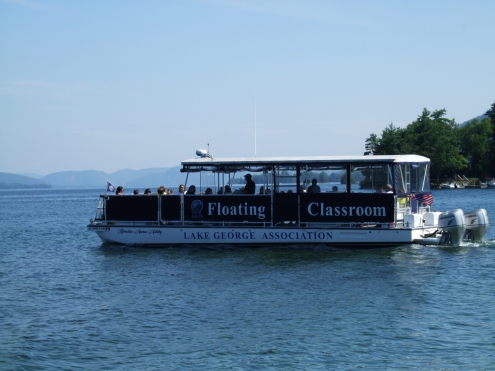
The LGA’s Floating Classroom as seen off of Huletts Landing in 2011.
The Lake George Association is pleased to announce that it has received $10,000 from the Helen and Ritter Shumway Foundation. The foundation was created from the estate of the late Helen Shumway to support conservation efforts. Facilitated by Jack Murphy at Bank of America, a manager of the Foundation, the funding will help support the LGA’s Floating Classroom program as well as Asian Clam management efforts.
The Floating Classroom is central to the mission of the Lake George Association, and a core element of its educational program. The program was originally conceived in 1990 as a means to provide a stirring, enlightening experience to area school children and to help them develop a stewardship interest in the Lake George ecosystem. The program has since grown and today has even expanded to include family groups and tourists in the summer season. The LGA’s Floating Classroom provides a unique hands-on experience for participants to learn about Lake George and how they can help protect it for the future. 2,228 people took part in the Floating Classroom program in 2013, over half of which were students on field trips in the spring and fall.
“We are so happy that we are able to offer the program for groups in the summer in addition to our usual school field trips. This new funding from the Shumway Foundation will help us be able to continue those programs,” said LGA’s Education Coordinator Kristen Rohne. “Everyone who goes out on the boat tells us how amazed they are with what they learn. For many people, this is the first and only time they will get to catch plankton and look at them under a microscope or use a secchi disk to measure water clarity,” said Rohne.
Asian clams were first found in Lake George in the fall of 2010 off Lake Avenue Beach in Lake George Village. Management efforts to kill the clams began right away in the spring of 2011, however unfortunately it has since spread to additional locations around the Lake. As of the most recent lake-wide survey completed this past September the clams have been found in 13 locations around the Lake. “The LGA and many partners have been working hard to keep this highly invasive species under control but its amazing reproductive capabilities seem to be keeping the clams one step ahead,” said LGA’s Executive Director Walt Lender. “We are continuing to work to better understand how the clams reproduce and spread, and then hope to use this information to better inform our future management efforts. Our experience with Asian clam illustrates how important education and prevention really are and why programs like the LGA’s Floating Classroom and Lake Stewards are so critical. We are very grateful to the Shumway Foundation for supporting these important programs.”
Bits of Everything
Magic Salt on Lake George Streets
Denton publications spotlights the village of Lake George using a new substance instead of traditional rock salt on local roads.
Lindsey Jacobellis: Olympic Profile of US Snowboard Hopeful for Sochi 2014
Bleacher Report profiles Vermont snowboarder Lindsey Jacobellis, with a video of her agonizing 2006 Torino loss.
Saturn and its Moons in Holiday Dress
NASA’s Jet Propulsion Laboratory has some amazing pictures of Saturn and its moons as seen by the Cassini spacecraft.
Retired Saratoga Racehorse, Metro, Pays Medical Bills By Painting
LGA Partners with the Town of Lake George to Address Stormwater Issues at Usher Park
The Lake George Association and the Town of Lake George have been working together to address stormwater runoff issues at Usher Park. The majority of the park is very steeply sloped down to the Lake, making stormwater a perennial issue at this location. While the Town has existing stormwater controls on the site, they are undersized for the amount of runoff the property receives after a heavy rain, much of which comes from off the property, further uphill in the watershed and funnels down into the Park.
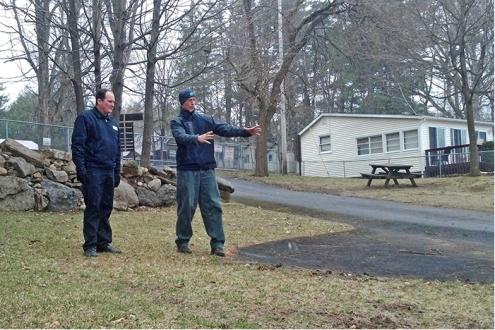
LGA’s Project Manager Randy Rath with Jim Martino from the Town of Lake George.
“This past spring in April when the snow was still flying, LGA and Town staff met on site at the park to discuss how to best capture the stormwater. A combination of plantings and stormwater structures were planned for the site. The LGA then applied for funding from the Helen V. Froehlich Foundation for the project and we are happy to announce that we received $18,000 for the project this past summer,” said LGA’s Project Manager Randy Rath.
Work began right away this fall with native plantings along the shoreline with some funding for plant material available from the Town of Lake George. New York native perennials including Spotted Phlox, Nodding Onion, and Blue Lobelia and were planted along with shrubs such as Steeplebush and Summersweet. The Town also provided the labor and materials, creating a new planting bed on the left side of the beach in an area where the runoff coming down the hill would just wash right down onto the beach and out into the Lake. Staff from the LGA designed and planted the garden with native plants grown locally at Fiddlehead Creek Native Plant Nursery. The new planting will now help slow the runoff and keep it out of the Lake.
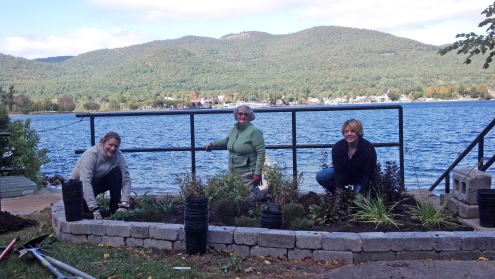
LGA staff worked with the Town of Lake George to plant a new native plant buffer along the shoreline of Usher Park this fall. Pictured above from left to right are LGA staffers Nancy Cobb-Zoll, Mona Seeger, and Alicia Nichols.
After planting along the shoreline, LGA and Town staff moved uphill and worked to stabilize a slope on the park property next. Two different native groundcovers were utilized here – Foamflower and Barren Strawberry. Not only will the native plants help stabilize the slope, reducing erosion from runoff, but they also are aesthetically pleasing for the park setting and make maintenance of the property easier for Town staff, who had a hard time mowing such a steep area in the past. 100 feet of straw wattle was installed along the bottom edge of the slope to ensure stabilization of the site while the groundcovers take hold. “Next year, park users can enjoy beautiful yellow flowers on the Barren strawberry followed by the airy carpet of white flowers of the Foamflower and they might not even realize that the planting is a stormwater project!” said DeBolt.
Native groundcovers are a great way to stabilize steep slopes. This was not the first time the LGA has worked to stabilize a steep slope in a public park with native plants. In 2010 the LGA partnered with the Town and Village of Lake George to stabilize the slope at the north end of Shepard’s Park with native plants.
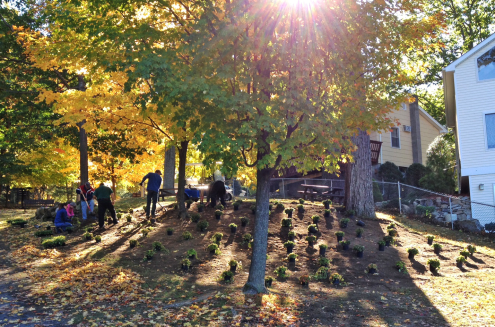
Staff from the LGA and the Town of Lake George worked to plant this steep slope with native groundcovers. The groundcover will fill in, stabilizing the slope and preventing any future erosion.
“We are pleased to be building on our past successes, making our partnerships stronger all the time,” said LGA’s Executive Director Walt Lender. “Last year we worked with the Town of Lake George to help address some stormwater issues and installed a native plant demonstration garden in front of the Town Hall. We continued our partnership again this year with work at Usher Park. There are so many projects that need to be done around the lake, and partnerships such as ours with the Town are the most efficient way to get many of these projects done. We are glad to be continuing our work with them, as well as other Towns around the Lake, next year.”
Since there is a large amount of runoff at the site, more storage capacity is needed than the small areas available for planting could provide. “The native gardens installed this fall were a great start, but there is still more work that needs to be done,” said LGA’s Project Manager Randy Rath. “A series of dry wells and other stormwater management structures will be installed in the spring to catch larger amounts of runoff further up the hill before it makes it to the bottom. That is where the majority of the funding secured from the Helen V. Froehlich Foundation this year will be needed. We already have a concept and will finalize the design this winter with Warren County Soil and Water, so we are all set to start in the spring. Jim Martino at the Town of Lake George has been instrumental in all this. He called us up and said they were having some stormwater problems at the Park and asked if we could take a look. We are excited that the Towns look to us as a partner in protecting the Lake. We have strived to build good relationships with all of the municipalities over the years and we can see that all the hard work is paying off. ”
Foster Brook Summer Flood Revisited: Where Did the Water Come From?
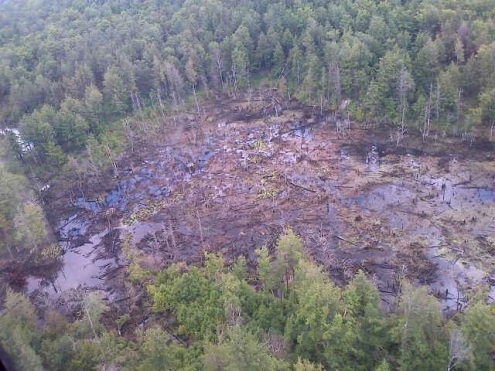
The area of the beaver pond (that is believed to have caused the 2013 Foster Brook flood) after the dam break (LGPC-DEC-State Police Photo). (Click picture to see larger view.)
During the midst of the 2013 summer Foster Brook flood, the thought running through my mind was; “Where is all this water coming from?” There had been no rain for days and there weren’t any flood warnings in effect. The day was mildly cloudy. The flash flood came down the mountain suddenly, severely eroding the area of Foster Brook while also jumping the bank and causing damage to nearby roads and homes.
Well, thanks to Randy Rath, of the Lake George Association, here is a Google Earth map showing exactly where the water supposedly originated.
It is believed that the flood was started by a beaver dam failure constructed on the upstream pond pictured in the center of the Google map. The water held back by the dam was estimated at about 9 +acres and was all but entirely drained after the dam washed away. The resulting sediment washed down into Lake George was thus ultimately believed to have been caused by wild beavers.
What can be done to prevent this from happening again? Well according to Bob Banks, Town Supervisor of Dresden, the town does have funds available in its yearly budget for beaver dam removal. The problem was that no one knew about this area. To keep it from happening again, the area would need to be monitored to see if the area is being “dammed” again, resulting in a water buildup.
At least the question; “Where did the water come from?” may now be answered.


